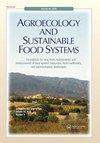超声波冲击后地衣提取物的检测
IF 2.6
3区 农林科学
Q1 AGRICULTURE, MULTIDISCIPLINARY
Agroecology and Sustainable Food Systems
Pub Date : 2023-07-13
DOI:10.21323/2618-9771-2023-6-2-171-179
引用次数: 0
摘要
人体健康营养的一个组成部分是摄入生物活性物质。提取是从植物中分离不同生物活性物质的重要步骤,超声处理的应用提高了提取活性物质的有效性。本研究的目的是研究不同类型的水介质和处理方法对岛天竺鼠的影响,包括超声波处理原理和浸渍方法(输液)的使用。实验研究包括检测水介质(溶剂)的活性酸度对几种物理化学和流变性指标的影响以及对提取的影响方法。采用离子滴定法测定活性酸度和氧化还原电位;通过测量光密度和透射系数来确定酚醛物质聚合形式的动态粘度和输出深度。利用回归分析对数据进行数学处理。结果以图表、表格和回归方程的形式呈现。在pH = 7.0和рН = 9.0的溶剂条件下,从天竺葵到其提取物的物质转移率较高。用输注法提取提取物时,过渡过程中高分子化合物的含量是单体酚类化合物含量的1.3倍。在碱性培养基中,用输注法得到的提取液样品的动态黏度最高。所得提取物可用于食品系统建模。本文章由计算机程序翻译,如有差异,请以英文原文为准。
Examination of the extract from lichen (Cetraria islandica) after an ultrasonic impact
An integral part of human healthy nutrition is intake of biologically active substances. Extraction is an important stage of isolation of different bioactive substances from plants and effectiveness of their extraction increases with the use of ultrasonic treatment. The aim of this research was to study an effect of different types of aqueous media and treatment methods on Cetraria islandica, including the use of principles of ultrasonic treatment and maceration methods (infusion). The experimental studies consisted in detecting an effect of the active acidity of the aqueous medium (solvent) and method of impact upon extraction on several physicochemical and rheological indicators. The experimental samples of extracts were examined by the following indicators: active acidity and redox potential detected by the ionometric technique; dynamic viscosity and the depth of output of polymeric forms of phenolic substances determined by measuring the optical density and transmission coefficient. Mathematical processing of data using the regression analysis was carried out. The results are presented as graphs, tables and regression equations. It has been established that transfer of substances from Cetraria islandica to its extracts had high results at pH = 7.0 and рН = 9.0 of the solvent. When obtaining extracts by the infusion method, the quantity of polymeric compounds in the transition process was 1.3 times higher than the quantity of monomeric forms of phenolic compounds. The highest value of the dynamic viscosity was revealed in the extract sample obtained by the infusion method in the alkaline medium. The extracts obtained can be used in food system modeling.
求助全文
通过发布文献求助,成功后即可免费获取论文全文。
去求助
来源期刊

Agroecology and Sustainable Food Systems
AGRICULTURE, MULTIDISCIPLINARY-GREEN & SUSTAINABLE SCIENCE & TECHNOLOGY
CiteScore
4.80
自引率
7.70%
发文量
73
期刊介绍:
Agroecology and Sustainable Food Systems is devoted to the rapidly emerging fields of agroecology and food system sustainability. By linking scientific inquiry and productive practice with transformative social action, agroecology provides a foundation for developing the alternative food systems of the future. The journal focuses on the changes that need to occur in the design and management of our food systems in order to balance natural resource use and environmental protection with the needs of production, economic viability, food security, and the social well-being of all people.
Agroecology and Sustainable Food Systems examines our current food systems from production to consumption, and the urgent need to transition to long-term sustainability. The journal promotes the study and application of agroecology for developing alternatives to the complex problems of resource depletion, environmental degradation, a narrowing of agrobiodiversity, continued world hunger, consolidation and industrialization of the food system, climate change, and the loss of farm land. The journal uses a food systems approach, and seeks experiences in agroecology that are on-farm, participatory, change-oriented, and backed by broad-based methodologies of sustainability analysis and evaluation.
 求助内容:
求助内容: 应助结果提醒方式:
应助结果提醒方式:


